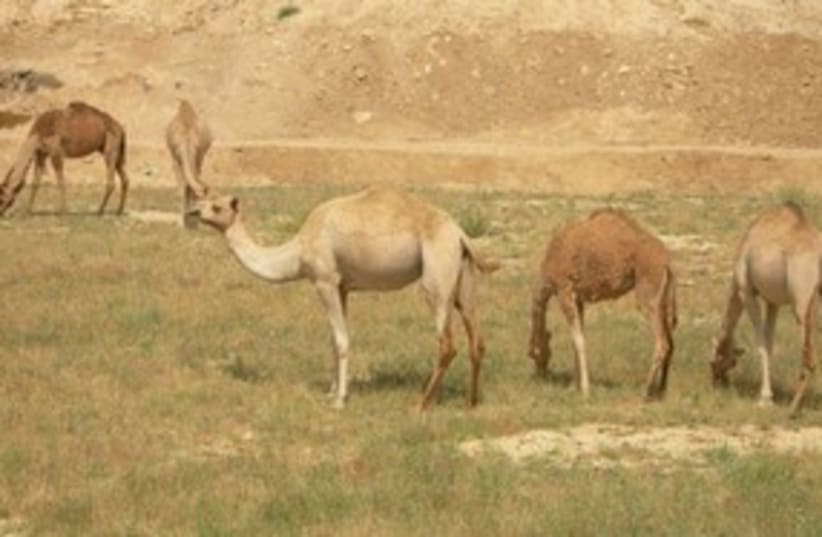And the Lord spoke unto Moses, saying: 'Send thou men, that they may spy out the land of Canaan, which I give unto the children of Israel…'Now the time was the time of the first-ripe grapes…So they went up, and spied out the land from the wilderness of Zin…And they went up into the South…and cut down from thence a branch with one cluster of grapes, and they bore it upon a pole between two…And they returned from spying out the land at the end of forty days (Numbers 13:1-25).This was the southern most border of the Land of Israel as designated by Moses and later Joshua. The Children of Israel came to this area and camped here during the exodus and spied out the land to the north only to be frightened back into the desert by the Canaanites and forced to wander the wilderness, for forty years because of their lack of faith. Only after the entire generation had died off, and a new, hardened and free Israelite population comes into maturity does Joshua lead them into war with the Canaanites.Follow this beautiful trail up the Divshon Heights for some of the most spectacular scenery in all Israel. About a kilometer up the trail there is an unmarked trail to your right that will take you 518 meters above sea level to an overlook of the Wilderness of Zin. There are many springs in this area and it would make for a good camp site for the hundreds of thousands of Israelites wandering the area. Below you to the north are the tombs of David & Paula Ben Gurion at the college. They choose to be buried here overlooking the entrance of the Promised Land for the children of Israel. Continue up the trail another kilometer. You will get to another terrific lookout called the Birds Overlook. See if you can spot a couple of reddish-brown Long Legged Buzzards or Egyptian Vultures known to inhabit this area.After about two more kilometers you will get to the Palm Trees Overlook. Look for flint near the trail along the way as prehistoric man is known to have inhabited the area. Continue on the green marked trail enjoying the view until you get to a blue marked trail which descends into the oasis of the Spring (Ein) of Akev. Enjoy the quiet, the falls and the scenery before continuing on down the wide blue trail for about two and a half kilometers then left on the wide red trail about three kilometers back to your car. If you have a jeep you can reach the spring by these wide trails and skip the hike.Joe Yudin became a licensed tour guide in 1999. He completed his Master’s degree at the University of Haifa in the Land of Israel Studies and is currently studying toward a PhD.
Off the Beaten Track: Hiking the Negev wilderness
Travel expert Joe Yudin introduces "the road less travelled" as well as some new discoveries at more well-known sites.

And the Lord spoke unto Moses, saying: 'Send thou men, that they may spy out the land of Canaan, which I give unto the children of Israel…'Now the time was the time of the first-ripe grapes…So they went up, and spied out the land from the wilderness of Zin…And they went up into the South…and cut down from thence a branch with one cluster of grapes, and they bore it upon a pole between two…And they returned from spying out the land at the end of forty days (Numbers 13:1-25).This was the southern most border of the Land of Israel as designated by Moses and later Joshua. The Children of Israel came to this area and camped here during the exodus and spied out the land to the north only to be frightened back into the desert by the Canaanites and forced to wander the wilderness, for forty years because of their lack of faith. Only after the entire generation had died off, and a new, hardened and free Israelite population comes into maturity does Joshua lead them into war with the Canaanites.Follow this beautiful trail up the Divshon Heights for some of the most spectacular scenery in all Israel. About a kilometer up the trail there is an unmarked trail to your right that will take you 518 meters above sea level to an overlook of the Wilderness of Zin. There are many springs in this area and it would make for a good camp site for the hundreds of thousands of Israelites wandering the area. Below you to the north are the tombs of David & Paula Ben Gurion at the college. They choose to be buried here overlooking the entrance of the Promised Land for the children of Israel. Continue up the trail another kilometer. You will get to another terrific lookout called the Birds Overlook. See if you can spot a couple of reddish-brown Long Legged Buzzards or Egyptian Vultures known to inhabit this area.After about two more kilometers you will get to the Palm Trees Overlook. Look for flint near the trail along the way as prehistoric man is known to have inhabited the area. Continue on the green marked trail enjoying the view until you get to a blue marked trail which descends into the oasis of the Spring (Ein) of Akev. Enjoy the quiet, the falls and the scenery before continuing on down the wide blue trail for about two and a half kilometers then left on the wide red trail about three kilometers back to your car. If you have a jeep you can reach the spring by these wide trails and skip the hike.Joe Yudin became a licensed tour guide in 1999. He completed his Master’s degree at the University of Haifa in the Land of Israel Studies and is currently studying toward a PhD.